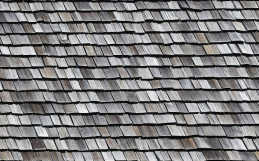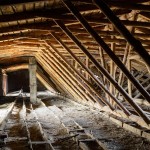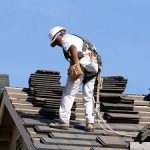Types of Materials that Make Up a Residential Roofing System
There are many different types of materials that make up a residential roofing system, although we only really see roof shingles, shakes, or tiles that make up the roof. There is also a wide range of roof components that help prevent water from entering the home, either through the roof or along the foundation.
Other roofing components may include skylights, plumbing vents, chimneys, or other outcroppings. Let’s take a look at many of the elements that make up the roof of your home and how they prevent water from entering the house.
Roofing Materials
Sheathing – Sheathing, also known as roof decking, is plywood that is put down over the rafters in the attic and the first step of a roofing system. Although local codes or regulations may differ, the plywood is usually at least ⅜ of an inch thick. The sheathing is what the underlayment and then shingles will be attached to.
Underlayment – Installed between the roofing materials and the decking, underlayment is a water barrier that further protects the home. It is installed in much the same way the roofing is: Start from the bottom and overlap rows until you get to the top of the roof.
There are two main types, tar/felt paper and synthetic underlayments. There are differences between the two, including price, weight, installation methods, and durability. But no matter which material you go with, underlayment plays a vital role in protecting your home.
Even flat roofing uses underlayment, although it is a completely different material altogether. This fiberboard (similar to the cement board you would install behind a shower surround) is covered with roofing adhesive to create a strong bond with the EPDM roofing membrane.
Roofing – This is where the major decisions for your roofing system are made. Although asphalt shingles were the default choice for the majority of homes two decades ago, your choices as a homeowner have grown dramatically. Each has its own benefits (and drawbacks), but with so many options you can get the roof you want.
- Metal Roofs come in a variety of colors and profiles, are very lightweight, and are one of the longest-lasting roofing materials on the market. But they are also one of the more expensive options, too, and need expert installation.
- Slate is very durable and its natural beauty lends an air of elegance to any roof. But it is extremely heavy and may require extra support. And even though they can last for a century, they can be brittle when not handled correctly.
- Clay/Concrete Tiles are also quite durable but could suffer the same fate as slate when walked on or mishandled. Less expensive than slate, they can be made in different colors. But weight could be an issue as well.
- Cedar Shake shingles have a distinctive look that is right at home on a lakeside retreat or home in the countryside. This material needs a lot of maintenance however and will never last as long as metal, slate, or concrete.
- Architectural/Composite Shingles resemble the asphalt shingles of your and the three-tab shingles of today but are much more durable. They are available in different designs and colors and are easier to repair/replace than other more distinct roofing materials.
- Three-Tab Shingles are widely used today because it’s easy to work with, inexpensive, and easy to find replacements. But they just don’t last as long as other materials and can be damaged during particularly stormy weather.
In some cases, roofing contractors may need to use furring strips for certain kinds of roofing material, most commonly with metal roofing. These strips of wood are used to provide some air circulation to decrease condensation between the metal roofing and the underlayment.
For flat roofs, there are basically three types of roofing materials: Built-Up (BUR), Modified Bitumen, and rubber membrane or EPDM (ethylene propylene diene monomer). BUT is made up of multiple layers of waterproof material interspersed with hot tar and topped with river rock or gravel.
Modified bitumen roof covering is a single-ply material that is rolled out and then sealed into place with a torch, although there are “peel and stick” products on the market EPDM is a rubber membrane that is rolled out and held in place with fasteners, glue, or weight down with stones. It is durable and less resistant to scuffs than the other products, but punctures can be a concern.
Roof Components
There are other roof components that work together to keep your home safe from the elements. In smaller homes, you may just have the peak of the roof (ridge) where the two sides of the pitched roof come together at the top. The eaves are the part of the roof that extends beyond the exterior walls of the home.
Fascia boards are found along the edges of the roof to help protect the ends of the roof as well as provide a finished look to the home. In most cases, gutters are attached to the fascia board because it provides a solid surface for the gutter fasteners. Soffits are the area underneath the eaves where vents can be installed to improve air circulation to the attic.
Flashing is a very important part of your roof and is used along chimneys, valleys in the roof, roof vents, vent pipes, skylights, and more. This is a bent piece of metal that fits underneath the roofing material to keep ice and water from seeping into the home where the roofing is interrupted.
Dormers are outcroppings from the roof to provide more room on the inside of the home or to create a point of interest. Valleys are created when dormer roofs meet the main sloped roof plane, creating a seam. A “hip” is where different roof edges meet to create a ridge instead of a valley. These ridges require specifically made shingles to cover the peak.
No matter what kind of roofing material you have, if it starts to leak, it may be time to start thinking about a new roof. Reach out to Warner Construction if you have any concerns about your roof and we can perform a thorough inspection.







